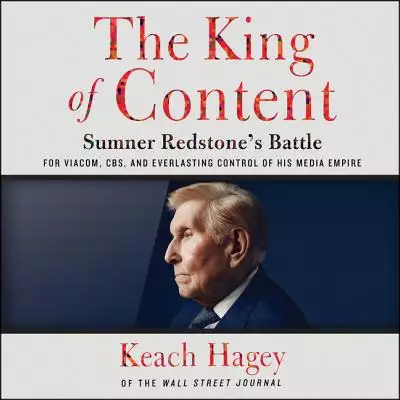Viacom stock的問題,我們搜遍了碩博士論文和台灣出版的書籍,推薦Hagey, Keach/ Zackman, Gabra (NRT)寫的 The King of Content: Sumner Redstone’s Battle for Viacom, CBS, and Everlasting Control of His Media Empire 可以從中找到所需的評價。
國立臺灣大學 法律學研究所 蔡英欣所指導 曹廷豪的 雙層股權結構之應用—以控制權角度出發 (2018),提出Viacom stock關鍵因素是什麼,來自於雙層股權結構、複數表決權股、控制權、條款設計。
而第二篇論文國立臺北商業大學 國際商務系碩士班 黃仲楷所指導 陳俊仰的 Y世代接受無分行銀行之實證分析-以台灣地區為例 (2017),提出因為有 無分行銀行、Y世代、UTAUT、感知價值、感知風險、個人創新程度的重點而找出了 Viacom stock的解答。
The King of Content: Sumner Redstone’s Battle for Viacom, CBS, and Everlasting Control of His Media Empire

為了解決Viacom stock 的問題,作者Hagey, Keach/ Zackman, Gabra (NRT) 這樣論述:
Sumner Murray Redstone, once feared as the "mad genius" of media who would dump his CEOs for mere wobbles in his companies' stock price, had built one of the world's greatest media empires through a series of audacious takeovers constructed to ensure that he always maintained control. Today he contr
ols 80% of the voting shares of both Viacom and CBS, meaning that on a whim he could replace the entire boards of two public companies with a combined value of $40 billion. He spent decades performing meticulous estate planning so that his control would extend beyond the grave (which he loved tellin
g reporters he would never lie in), constructing trusts designed to make it impossible for his heirs to sell his companies after he died. "Unless they start doing terribly," he told the Wall Street Journal in 2012, "which they will not."As readers will discover in The King of Content, Redstone's con
fidence at the time was not misplaced. His life up to that point had been a story of exceeding expectations, climbing from the son of a linoleum peddler in the Jewish immigrant tenements of Boston's West End to Harvard Law School, from the president of his father's regional drive-in movie chain to t
he owner of Viacom, from a cerebral lawyer who shopped at Filene's Basement to the owner of a coveted Hollywood studio, and ultimately, after the Viacom-CBS merger, to the controlling shareholder of the largest merged media entity in U.S. history. The credo that he coined and repeated for decades--"
content is king"--turned out to be more true in the digital world than he could have ever guessed.Through exclusive interview and hundreds of pages of legal documents, Keach Hagey reveals the story behind the rise and fall of this remarkable figure, and the details of the family members fighting for
control of his vast empire. At the heart of all the dueling lawsuits running through the Redstone family is Sumner Redstone's tumultuous love life --particularly the fallout from his 2002 divorce from Phyllis, his wife of 52 years. More recently, Redstone's life has become a tabloid soap opera than
ks a lawsuit brought by one of his ex-girlfriends, Manuela Herzer. If the judge finds him incompetent, it will greatly increase the pressure on his trustees to begin the process of placing his controlling stakes in the hands of a seven-person trust who are expected to duke it out over what will beco
me of the companies.Yet the appetite for Redstone's assets is not what it would have been just a few years ago. While CBS--bolstered by its sports rights and the programming prowess of its former actor CEO, Les Moonves--has experienced modest declines in the age of cord-cutting, Viacom's fall has be
en dizzying. Ratings at its biggest cable networks, which include MTV, Comedy Central, Nickelodeon, BET, and Vstrong, have been falling double-digit percentages for years. A few small cable companies, annoyed at Viacom's demands for price hikes for their entire package of dozens of channels when rat
ings were so weak, dropped them altogether last year--a move widely viewed as a canary in the industry coal mine.There's a corporate whodunnit here, as well as a series of mysteries that has captivated both the business and tabloid press. The answers lie in family feuds, corporate battles and allian
ces that go back decades, and will be laid bare in this ambitious book.
雙層股權結構之應用—以控制權角度出發
為了解決Viacom stock 的問題,作者曹廷豪 這樣論述:
我國公司法第356條之7開放閉鎖性股份有限公司得使用複數表決權股建立雙層股權結構,以維護公司創辦人對公司的控制力。這樣的法制彈性於2018年7月經立法院通過公司法修正案,第157條開放非公開發行公司亦得使用複數表決權股,然而主管機關立基於避免萬年董監事之立場,仍抱持著相對保守的看法,尚未開放公開發行公司使用複數表決權股。因此本文將從控制權談起,討論握有公司控制權之目的及意義,以突顯維護控制權機制之重要性。其後切入探討雙層股權結構制度之優點缺失、案例及各項爭議,並針對缺失提出可能的條款設計,以降低使用此制度之風險。從而認為制度本身並無所謂優劣,只要對於弊端及風險能加以降低或防免,使機制利用效益
大於缺失則仍不失為一個好機制。於文末將回歸我國法並針對現行法制提出相關建議,以期待未來此機制能更加地被活用,並開放初次公開發行公司亦有使用之機會,使創業者在公司進入成長期時,不因缺少資金而致生商業成果需拱手讓人之飲恨結果,並使創業者迴避可能面對的公司成長與維護控制權之抉擇問題。
Y世代接受無分行銀行之實證分析-以台灣地區為例
為了解決Viacom stock 的問題,作者陳俊仰 這樣論述:
無分行銀行是從開發中國家崛起的創新銀行服務,藉由使用大量資訊科技和創新服務管道的服務,這樣的特性有潛力解決過度金融或低度金融的問題,因此在國外帶來了破壞性的創新。本研究使用混合方法(mixed method)探討影響台灣Y世代使用無分行銀行的因素。為了解無分行銀行影響因素,本研究以整合科技接受模型和感知價值理論為基礎,並結合創新擴散理論來探討。在量化分析方面,使用方便抽樣法在台灣北部及中部地區收集Y世代及非Y世代樣本,並收回345份有效問卷其中182份為Y世代,在質化分析方面,收集8份深入訪談樣本,其中4份為Y世代。問卷回收後,利用AMOS和SPSS統計軟體進行結構方程模型分析和獨立樣本T檢
定,結合質化分析技術進行資料分析。在無分行銀行研究情境下,本研究提出以下幾點發現:(1). Y世代的預期努力不影響行為意圖;(2). Y世代的感知利益會藉由感知價值中介變數進而影響正面行為意圖;(3). Y世代的感知風險會負面顯著影響行為意圖;(4). Y世代的個人金融創新程度會正面顯著影響行為意圖。